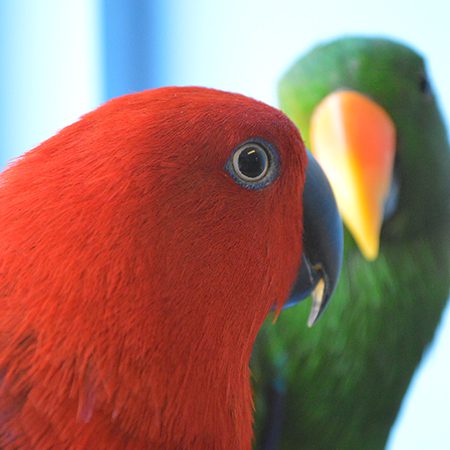Eclectus Parrot
Eclectus roratus
The eclectus parrot is native to the Solomon Islands, Indonesia, New Guinea and northeastern Australia. They come in a variety of sub-species, including the Grand Eclectus, the Vosmaeri, and the Solomon Island Eclectus, with the latter being the most commonly found in captivity. It is known in the parrot family for its dimorphism, meaning that there are visual distinctions between the sexes. When these parrots were first discovered by European ornithologists, it was thought that the eclectus parrots were two distinct breeds.
The diet of the eclectus in the wild consists of mainly fruits, wild figs, unripe nuts, flower and leaf buds, and some seeds. In captivity, they eat most fruits including mangos, figs, guavas, bananas, melons, stone fruits, grapes, citrus fruits, pears, apples, pomegranate, and papaya.
A stocky short-tailed parrot, it measures around 14 in. in length. The male is mostly bright green with a yellow-tinge on the head. It has blue primaries, red flanks and underwing coverts. Its tail is edged with a narrow band of creamy yellow, and is dark grey edged with creamy yellow underneath, and the tail feathers are green centrally and more blue as they get towards the edges. Most female eclectus parrots are bright red in color. Their abdomen and nape are mostly blue with the mantle and underwing a darker more purple color. The wings are edged with a mauve-blue. The tail is edged with yellowish-orange above, and is more orange tipped with yellow underneath.

Eclectus Parrots are native to the Solomon Islands, Sumba, New Guinea and nearby islands of northern Australia.
HABITAT -Native to the Solomon Islands, Indonesia, New Guinea, and northeastern Australia.
DIET -Their wild diet consists of mainly fruits, pomegranate, papaya, figs, flowers, leaf buds and some seeds.
FUN FACT -They are known for their dimorphism, meaning that there are visual distinctions between the sexes.
SOCIAL BEHAVIOR -They are very social and affectionate parrots.
ACTIVITY -They are diurnal being most active during the day and resting during the evening.
PREDATORS -Predators include possums, birds of prey, and wild dogs.
SIZE -They measure around 14 in. in length, weighing around 16oz.
RELATIVES -There are nine subspecies of eclectus parrots, including the grand eclectus, vos eclectus, and the sumba island eclectus.
CONSERVATION -Eclectus Parrots are categorized as LC (Least Concern) species by the IUCN.
Cub Creek Animal Care Information
Housing - She is housed in a large cage with her nest box, and many different types of enrichment. Within the cage there are several branches for her to perch upon. The bottom of the cage is layered with newspaper to make clean up easy. Her food and water bowls are hung on the sides of the cage.
Diet - To ensure she gets all the necessary nutrients, she is fed ZuPreem FruitBlend large bird pellets as well as fresh fruits and vegetables such as apples, bananas, shredded sweet potato, and greens. She also loves getting peanuts as a treat! She is given access to fresh water everyday.
Enrichment - Parrots are very intelligent birds and therefore need lots of enrichment to keep them entertained. Their cages are filled with various hanging toys they can rattle and hang on; they love being given paper to shred. Just about anything that campers can make out of cardboard, chains, or nest boxes the birds will enjoy!


